1. Project overview
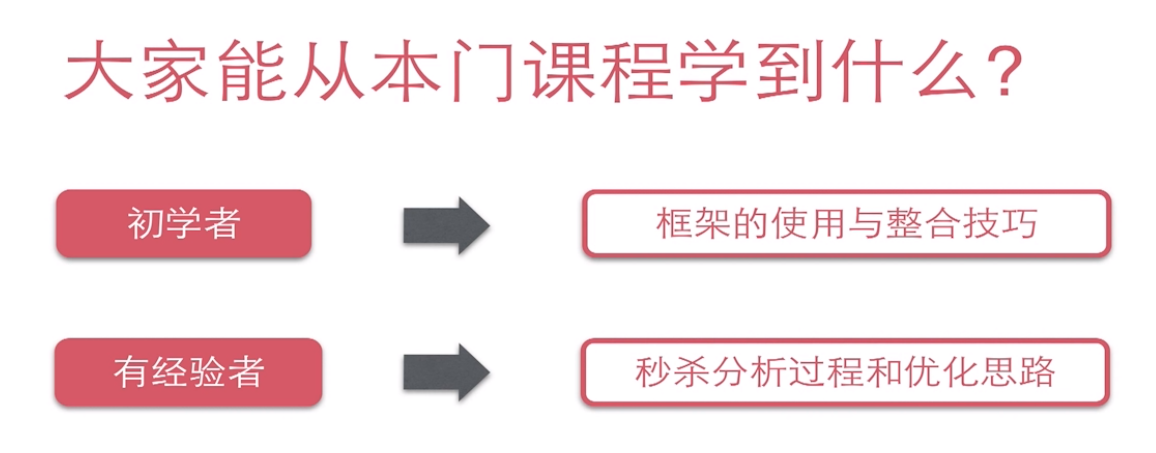
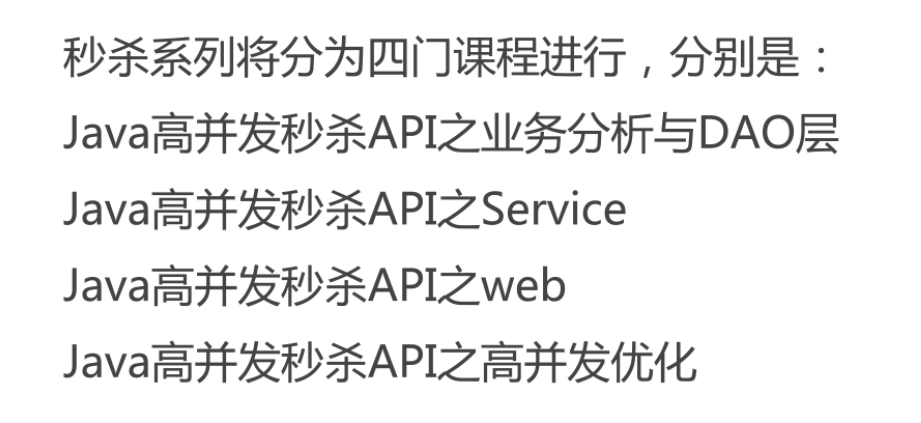
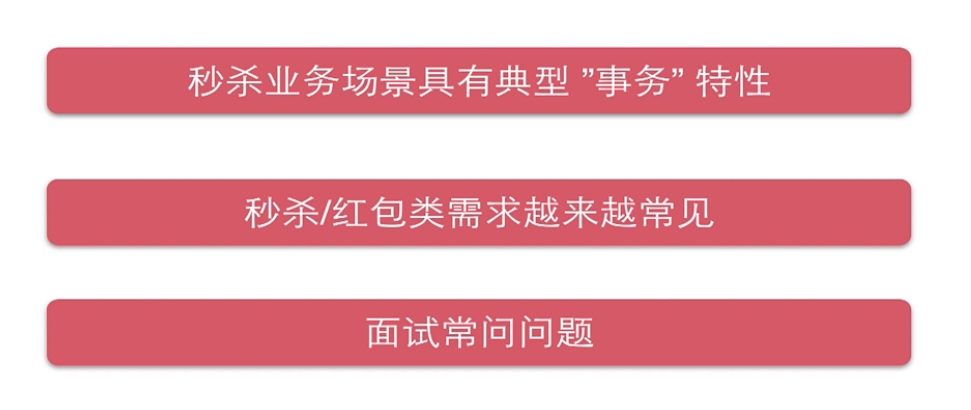
1.1 SSM framework advantages
- The framework is easy to use and lightweight
- Low code intrusion
- Mature community and user base
1.2 introduction to relevant technologies
1.MySQL
- Table design
- SQL skills
- Transaction and row level locks
2.MyBatis
- Design and development of DAO layer
- MyBatis rational use
- MyBatis and Spring integration
3.Spring
- Spring IOC integration Service
- Declarative transaction application
4.SpringMVC
- Restful interface design and use
- Framework operation process
- Controller development skills
5. Front end
- Interaction design
- Bootstrap
- jQuery
6. High concurrency
- High concurrency point and high concurrency analysis
- Optimize ideas and implement
1.3 second kill business analysis
1.3. 1. Business process of second kill system

1.3. 2. The core of second kill business: inventory processing
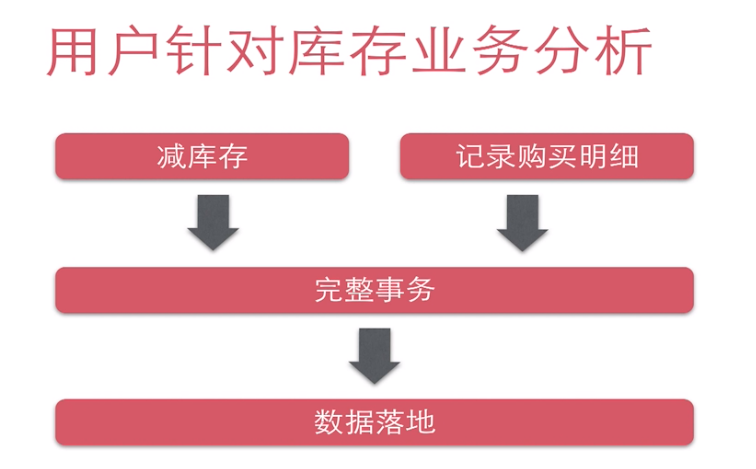
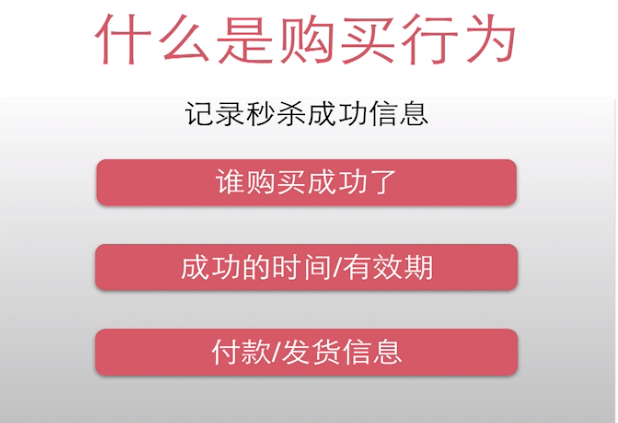
1.3. 3 why transactions are needed
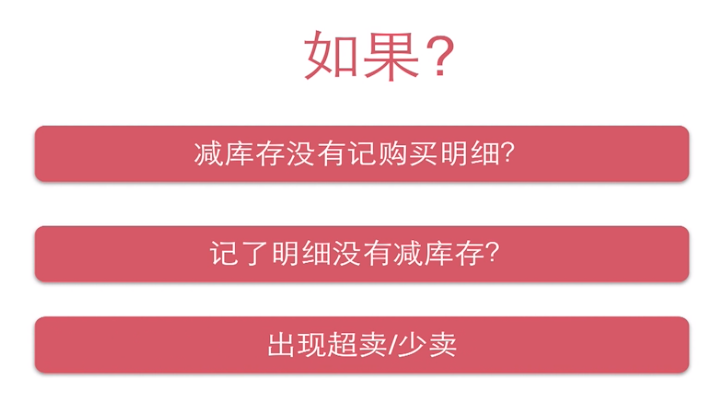
1.3. 4. Data landing
MySQL VS NoSQL
NoSQL: the transaction support is not very good, and the pursuit is performance, high availability and distributed
MySQL: the built-in transaction mechanism is still the most effective and reliable data landing scheme at present - > inventory reduction and purchase behavior can be recorded more reliably
1.4 difficulty analysis of MySQL second kill
Difficult problem: Competition - > transaction + row level lock
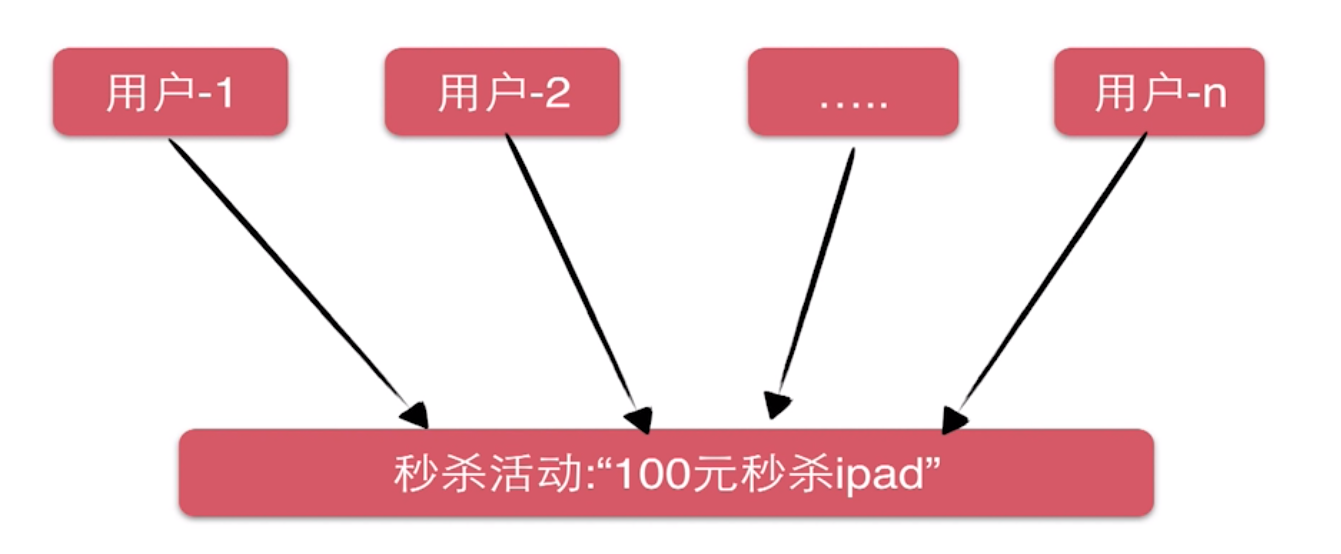
Transaction working mechanism:
- Start Transaction
- Update inventory quantity - > competition appears here
- Insert purchase details
- Commit
Row level lock - > with competition

How to deal with competition efficiently: high concurrency
1.5 what second kill functions can be realized
- Second kill interface exposure
- Execute second kill
- Related query: List query and detail page query
Code development phase
- DAO design coding: database table design, Dao interface, and how MyBatis implements Dao
- Service design code:
Service interface design and coding implementation, managing services through Spring, and labeling services through Spring declarative transactions. The method is a transaction operation to simplify transaction control - Web design coding: Restful interface, front-end interaction
2. Create projects and dependencies
2.1 description before creation
-
Create from scratch
-
Obtain relevant configurations from the official website
1. More comprehensive and authoritative documents
2. Avoid obsolescence or errors

-
Create a project using Maven
2.2 start creating project
- New Maven project
Maven installation and its configuration and use in IDEA (nanny tutorial)
- New Web project
Java learning [framework (III)] spring MVC (I) review MVC Architecture & Servlet
The results are as follows:

2.3 import dependency
<?xml version="1.0" encoding="UTF-8"?>
<project xmlns="http://maven.apache.org/POM/4.0.0"
xmlns:xsi="http://www.w3.org/2001/XMLSchema-instance"
xsi:schemaLocation="http://maven.apache.org/POM/4.0.0 http://maven.apache.org/xsd/maven-4.0.0.xsd">
<modelVersion>4.0.0</modelVersion>
<groupId>org.seckill</groupId>
<artifactId>seckill</artifactId>
<version>1.0-SNAPSHOT</version>
<dependencies>
<dependency>
<!-- use junit4(3.0 Programming mode is used by default, 4.0 Run in annotation mode later junit)-->
<groupId>junit</groupId>
<artifactId>junit</artifactId>
<version>4.11</version>
<scope>test</scope>
</dependency>
<!-- Complete project dependency -->
<!-- 1:journal java journal: slf4j, log4j, logback, common-logging
slf4j Is the norm/Interface
Log implementation: log4j, logback, common-logging
use: slf4j + logback
-->
<dependency>
<groupId>org.slf4j</groupId>
<artifactId>slf4j-api</artifactId>
<version>1.7.12</version>
</dependency>
<dependency>
<groupId>ch.qos.logback</groupId>
<artifactId>logback-core</artifactId>
<version>1.1.1</version>
</dependency>
<!-- realization slf4j Interface and integration -->
<dependency>
<groupId>ch.qos.logback</groupId>
<artifactId>logback-classic</artifactId>
<version>1.1.1</version>
</dependency>
<!-- 2. Database dependency -->
<!-- mysql drive-->
<dependency>
<groupId>mysql</groupId>
<artifactId>mysql-connector-java</artifactId>
<version>5.1.35</version>
<scope>runtime</scope>
</dependency>
<!-- Database connection pool-->
<dependency>
<groupId>c3p0</groupId>
<artifactId>c3p0</artifactId>
<version>0.9.1.2</version>
</dependency>
<!-- 3. DAO Frame: MyBatis rely on -->
<!-- MyBatis Self dependence -->
<dependency>
<groupId>org.mybatis</groupId>
<artifactId>mybatis</artifactId>
<version>3.3.0</version>
</dependency>
<!-- MyBatis Self implemented Spring Integration dependence -->
<dependency>
<groupId>org.mybatis</groupId>
<artifactId>mybatis-spring</artifactId>
<version>1.2.3</version>
</dependency>
<!-- 3. Servlet web Correlation dependency -->
<!-- jsp Corresponding label -->
<dependency>
<groupId>taglibs</groupId>
<artifactId>standard</artifactId>
<version>1.1.2</version>
</dependency>
<!-- js Default label Library -->
<dependency>
<groupId>jstl</groupId>
<artifactId>jstl</artifactId>
<version>1.2</version>
</dependency>
<!-- SpringMVC Default needs jackson -->
<dependency>
<groupId>com.fasterxml.jackson.core</groupId>
<artifactId>jackson-databind</artifactId>
<version>2.5.4</version>
</dependency>
<!-- servlet -->
<dependency>
<groupId>javax.servlet</groupId>
<artifactId>javax.servlet-api</artifactId>
<version>3.1.0</version>
</dependency>
<!-- 4. Spring rely on-->
<!-- 1)Spring Core dependency-->
<dependency>
<groupId>org.springframework</groupId>
<artifactId>spring-core</artifactId>
<version>4.1.7.RELEASE</version>
</dependency>
<dependency>
<groupId>org.springframework</groupId>
<artifactId>spring-beans</artifactId>
<version>4.1.7.RELEASE</version>
</dependency>
<dependency>
<groupId>org.springframework</groupId>
<artifactId>spring-context</artifactId>
<version>4.1.7.RELEASE</version>
</dependency>
<!-- 2) Spring DAO Layer dependence -->
<dependency>
<groupId>org.springframework</groupId>
<artifactId>spring-jdbc</artifactId>
<version>4.1.7.RELEASE</version>
</dependency>
<!-- Spring Transaction dependency -->
<dependency>
<groupId>org.springframework</groupId>
<artifactId>spring-tx</artifactId>
<version>4.1.7.RELEASE</version>
</dependency>
<!-- 3) Spring web Correlation dependency-->
<dependency>
<groupId>org.springframework</groupId>
<artifactId>spring-web</artifactId>
<version>4.1.7.RELEASE</version>
</dependency>
<dependency>
<groupId>org.springframework</groupId>
<artifactId>spring-webmvc</artifactId>
<version>4.1.7.RELEASE</version>
</dependency>
<!-- 4) Spring test Related dependencies (for unit testing) -->
<dependency>
<groupId>org.springframework</groupId>
<artifactId>spring-test</artifactId>
<version>4.1.7.RELEASE</version>
</dependency>
</dependencies>
</project>
3. Database design code
Java learning [framework (II)] MyBatis (I) the first MyBatis query program

- Create a new schema under main sql
(I connected to the database, but I didn't connect to MyBatis - > crazy MyBatis was configured in the resource. As of this step, I haven't configured it yet)

schema. The SQL statements in SQL are as follows:
-- Database initialization script -- Create database CREATE DATABASE `seckill`;
-- Use database use `seckill`;
-- Create a second kill inventory table CREATE TABLE `seckill`( `seckill_id` bigint NOT NULL AUTO_INCREMENT COMMENT 'Commodity inventory id', `name` varchar(120) NOT NULL COMMENT 'Trade name', `number` int NOT NULL COMMENT 'Inventory quantity', `start_time` datetime NOT NULL COMMENT 'Spike start time', `end_time` datetime NOT NULL COMMENT 'Spike end time', `create_time` datetime NOT NULL DEFAULT CURRENT_TIMESTAMP COMMENT 'Creation time', -- Design index -- idx by index abbreviation PRIMARY KEY (`seckill_id`), key idx_start_time(`start_time`), key idx_end_time(`end_time`), key idx_create_time(`create_time`) )ENGINE = InnoDB AUTO_INCREMENT = 1000 DEFAULT CHARSET = utf8 COMMENT 'Second kill inventory Watch';
-- Initialization data
insert into
`seckill`(`name`, `number`, `start_time`, `end_time`)
values
('1000 Yuan second kill iphone6', 100, '2015-11-01 00:00:00', '2015-11-02 00:00:00'),
('500 Yuan second kill ipad2', 200, '2015-11-01 00:00:00', '2015-11-02 00:00:00'),
('300 Yuan spike millet 4', 300, '2015-11-01 00:00:00', '2015-11-02 00:00:00'),
('200 Yuan second kill red rice note', 400, '2015-11-01 00:00:00', '2015-11-02 00:00:00');
-- Second kill success details -- Information related to user login authentication create table `success_killed`( `seckill_id` bigint NOT NULL COMMENT 'Second kill commodity id', `user_phone` bigint NOT NULL COMMENT 'User mobile number', `state` tinyint NOT NULL DEFAULT -1 COMMENT 'Status identification: -1: Invalid 0: Success 1: Paid 2: Shipped', `create_time` datetime NOT NULL COMMENT 'Creation time', PRIMARY KEY (`seckill_id`, `user_phone`), -- composite keys key idx_create_time(create_time) )ENGINE = InnoDB DEFAULT CHARSET = utf8 COMMENT 'Second kill success details';
Modify database field properties:
ALTER TABLE `success_killed` MODIFY `create_time` datetime;
Show how tables are created:
show CREATE TABLE `success_killed`;
CREATE TABLE `success_killed` ( `seckill_id` bigint(20) NOT NULL COMMENT 'Second kill commodity id', `user_phone` bigint(20) NOT NULL COMMENT 'User mobile number', `state` tinyint(4) NOT NULL DEFAULT '-1' COMMENT 'Status identification: -1: Invalid 0: Success 1: Paid 2: Shipped', `create_time` datetime DEFAULT NULL, PRIMARY KEY (`seckill_id`,`user_phone`), KEY `idx_create_time` (`create_time`) ) ENGINE=InnoDB DEFAULT CHARSET=utf8 COMMENT='Second kill success details'
The results are as follows:
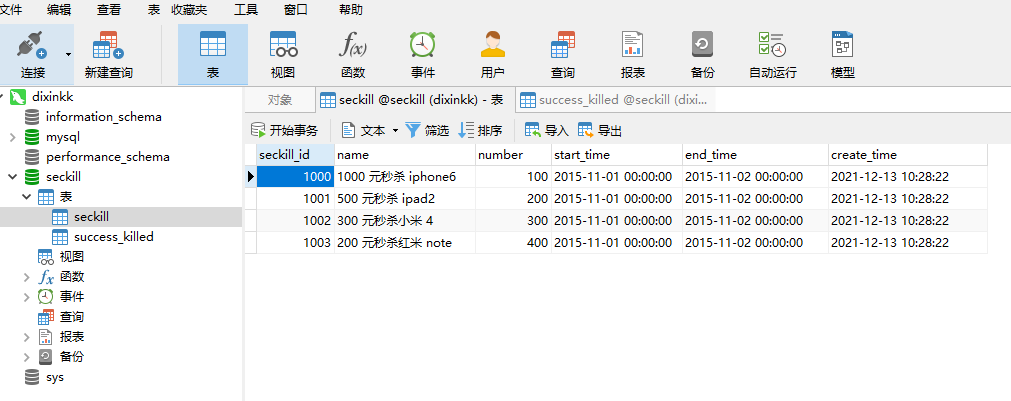
4. DAO layer entity and interface coding
Correspondence between label and entity
- The table corresponds to the entity class in Java
- Column corresponds to the attribute in the entity
Create entity package & Dao layer package
org.seckill.entity
org.seckill.dao
4.1 writing entity classes
4.1.1 Seckill entity class
package org.seckill.entity;
import java.util.Date;
public class Seckill {
private long seckillId;
private String name;
private int number;
private Date startTime;
private Date endTime;
private Date createTime;
// Alt + insert
public long getSeckillId() {
return seckillId;
}
public void setSeckillId(long seckillId) {
this.seckillId = seckillId;
}
public String getName() {
return name;
}
public void setName(String name) {
this.name = name;
}
public int getNumber() {
return number;
}
public void setNumber(int number) {
this.number = number;
}
public Date getStartTime() {
return startTime;
}
public void setStartTime(Date startTime) {
this.startTime = startTime;
}
public Date getEndTime() {
return endTime;
}
public void setEndTime(Date endTime) {
this.endTime = endTime;
}
public Date getCreateTime() {
return createTime;
}
public void setCreateTime(Date createTime) {
this.createTime = createTime;
}
@Override
public String toString() {
return "Seckill{" +
"seckillId=" + seckillId +
", name='" + name + '\'' +
", number=" + number +
", startTime=" + startTime +
", endTime=" + endTime +
", createTime=" + createTime +
'}';
}
}
4.1. 2 class successkilled
package org.seckill.entity;
import java.util.Date;
public class SuccessKilled {
private long skillId;
private long userPhone;
private short state;
private Date createTime;
// Flexible
// Many to one (composite attribute): one Seckill entity corresponds to multiple successful Seckill records
private Seckill seckill;
public long getSkillId() {
return skillId;
}
public void setSkillId(long skillId) {
this.skillId = skillId;
}
public long getUserPhone() {
return userPhone;
}
public void setUserPhone(long userPhone) {
this.userPhone = userPhone;
}
public short getState() {
return state;
}
public void setState(short state) {
this.state = state;
}
public Date getCreateTime() {
return createTime;
}
public void setCreateTime(Date createTime) {
this.createTime = createTime;
}
public Seckill getSeckill() {
return seckill;
}
public void setSeckill(Seckill seckill) {
this.seckill = seckill;
}
@Override
public String toString() {
return "SuccessKilled{" +
"skillId=" + skillId +
", userPhone=" + userPhone +
", state=" + state +
", createTime=" + createTime +
'}';
}
}
4.2 design DAO interface
4.2.1 SeckillDao interface
Naming convention: corresponding entity + Dao - > e.g. SeckillDao
package org.seckill.dao;
import org.seckill.entity.Seckill;
import java.util.Date;
import java.util.List;
public interface SeckillDao {
// Inventory reduction (killTime the time when inventory reduction is performed corresponds to the createtime in the database)
// If the number of affected rows > 1, it indicates the number of updated record rows
int reduceNumber(long seckillId, Date killTime);
// Query requirements (query the second kill object according to id)
Seckill queryById(long seckillId);
// Query the second kill product list according to the offset
// Offset: offset, limit: how many records are taken after the offset
List<Seckill> queryAll(int offet, int limit);
}
4.2. 2 successkilledao interface
package org.seckill.dao;
import org.seckill.entity.SuccessKilled;
public interface SuccessKilledDao {
// Insert purchase details to filter duplicates (joint unique primary key)
// Number of rows inserted
int insertSuccessKilled(long seckillId, long userPhone);
// Query SuccessKilled by id and carry the second kill product object entity
SuccessKilled queryByIdWithSeckill(long seckillId);
}